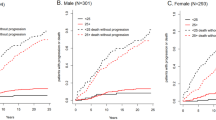Abstract
Individuals with monoclonal gammopathy of undetermined significance (MGUS) develop multiple myeloma and related malignancies at the rate of 1% per year. Given differences in ethnicity, data on prevalence and risk factors of MGUS in Thai population will be helpful in understanding the pathogenesis of plasma cell disorders and designing an early cancer detection strategy. Subjects of 50 years or older were included. Demographic data and suspected risk factors were collected. Monoclonal proteins were detected using serum protein electrophoresis. Serum was obtained from 3,260 participants; 1,104 males (33.9%) and 2,156 females (66.1%). The median age was 57 years (range 50–93 years). Monoclonal proteins were detectable in 2.3% (95% confidence interval [CI] 1.8–2.8). M spikes were found in gamma- and beta-globulin regions in 50 (1.5%) and 25 (0.8%) subjects, respectively. The prevalence of MGUS in subjects 50–59, 60–69, and 70 years or older was 2.0% (41/1,975), 2.6% (22/851), and 2.8% (12/434), respectively. By multivariate analysis, MGUS was associated with living outside Bangkok (odds ratio 2.25, 95% CI 1.11–4.58). The overall prevalence of MGUS in the Thai population was 2.3%, which was lower than that in Western countries, but comparable to that in Japan.
Similar content being viewed by others
References
Kyle RA, Rajkumar SV. Epidemiology of the plasma-cell disorders. Best Pract Res Clin Haematol. 2007;20:637–64.
International Myeloma Working Group. Criteria for the classification of monoclonal gammopathies, multiple myeloma and related disorders: a report of the International Myeloma Working Group. Br J Haematol. 2003;121:749–57.
Kyle RA, Therneau TM, Rajkumar SV, Offord JR, Larson DR, Plevak MF, et al. A long-term study of prognosis in monoclonal gammopathy of undetermined significance. N Engl J Med. 2002;346:564–9.
Kyle RA, Therneau TM, Rajkumar SV, Larson DR, Plevak MF, Offord JR, et al. Prevalence of monoclonal gammopathy of undetermined significance. N Engl J Med. 2006;354:1362–9.
Landgren O, Gridley G, Turesson I, Caporaso NE, Goldin LR, Baris D, et al. Risk of monoclonal gammopathy of undetermined significance (MGUS) and subsequent multiple myeloma among African American and white veterans in the United States. Blood. 2006;107:904–6.
Landgren O, Katzmann JA, Hsing AW, Pfeiffer RM, Kyle RA, Yeboah ED, et al. Prevalence of monoclonal gammopathy of undetermined significance among men in Ghana. Mayo Clin Proc. 2007;82:1468–73.
Iwanaga M, Tagawa M, Tsukasaki K, Kamihira S, Tomonaga M. Prevalence of monoclonal gammopathy of undetermined significance: study of 52, 802 persons in Nagasaki City. Japan Mayo Clin Proc. 2007;82:1474–9.
Lee LN, Jan IS, Tien HF, Lin JS, Lo SC, Cheng WC. Laboratory and clinical characterization of monoclonal gammopathy in Taiwanese. J Formos Med Assoc. 2002;101:91–7.
Munshi NC. Monoclonal gammopathy of undetermined significance: genetic vs environmental etiologies. Mayo Clin Proc. 2007;82:1457–9.
Iwanaga M, Tagawa M, Tsukasaki K, Matsuo T, Yokota K, Miyazaki Y, et al. Relationship between monoclonal gammopathy of undetermined significance and radiation exposure in Nagasaki atomic bomb survivors. Blood. 2009;113:1639–50.
Malik AA, Ganti AK, Potti A, Levitt R, Hanley JF. Role of Helicobacter pylori infection in the incidence and clinical course of monoclonal gammopathy of undetermined significance. Am J Gastroenterol. 2002;97:1371–4.
Katzmann JA, Clark RJ, Abraham RS, Bryant S, Lymp JF, Bradwell AR, Kyle RA. Serum reference intervals and diagnostic ranges for free kappa and free lambda immunoglobulin light chains: relative sensitivity for detection of monoclonal light chains. Clin Chem. 2002;48:1437–44.
Saleun JP, Vicariot M, Deroff P, Morin JF. Monoclonal gammopathies in the adult population of Finistère, France. J Clin Pathol. 1982;35:63–8.
Ogmundsdóttir HM, Haraldsdóttir V, Jóhannesson M G, Olafsdóttir G, Bjarnadóttir K, Sigvaldason H, et al. Monoclonal gammopathy in Iceland: a population-based registry and follow-up. Br J Haematol. 2002;118:166–73.
Landgren O, Weiss BM. Patterns of monoclonal gammopathy of undetermined significance and multiple myeloma in various ethnic/racial groups: support for genetic factors in pathogenesis. Leukemia. 2009;23:1691–7.
Cohen HJ, Crawford J, Rao MK, Pieper CF, Currie MS. Racial differences in the prevalence of monoclonal gammopathy in a community-based sample of the elderly. Am J Med 1998;104:439–44 [published correction appears in Am J Med. 1998;105(4):362].
Demographics of Thailand. http://en.wikipedia.org/wiki/Demographics_of_Thailand.
Lee JH, Lee DS, Lee JJ, Chang YH, Jin JY, Jo DY, et al. Multiple myeloma in Korea: past, present, and future perspectives Experience of the Korean Multiple Myeloma Working Party. Int J Hematol. 2010;92:52–7.
Rajkumar SV, Kyle RA, Therneau TM, Melton LJ 3rd, Bradwell AR, Clark RJ, et al. Serum free light chain ratio is an independent risk factor for progression in monoclonal gammopathy of undetermined significance. Blood. 2005;106:812–7.
Pasqualetti P, Collacciani A, Casale R. Risk of monoclonal gammopathy of undetermined significance: a case-referent study. Am J Hematol. 1996;52:217–20.
Landgren O, Kyle RA, Hoppin JA, Beane Freeman LE, Cerhan JR, Katzmann JA, et al. Pesticide exposure and risk of monoclonal gammopathy of undetermined significance in the Agricultural Health Study. Blood. 2009;113:6386–91.
Acknowledgments
The authors would like to thank Department of Clinical Pathology and Division of Immunology, Department of Microbiology, King Chulalongkorn Memorial Hospital for performing laboratory test and Panyawee Chaiyasirisuwan for administrative assistance. This work was supported by a grant from The National Research Council of Thailand.
Author information
Authors and Affiliations
Corresponding author
About this article
Cite this article
Watanaboonyongcharoen, P., Nakorn, T.N., Rojnuckarin, P. et al. Prevalence of monoclonal gammopathy of undetermined significance in Thailand. Int J Hematol 95, 176–181 (2012). https://doi.org/10.1007/s12185-011-0995-4
Received:
Revised:
Accepted:
Published:
Issue Date:
DOI: https://doi.org/10.1007/s12185-011-0995-4




